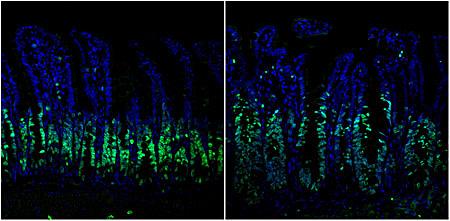![Immunofluorescent staining of intestinal epithelium tissue shows cell growth (green). In a normal mouse model (left), cell growth is controlled, but in a mouse model with the ERK1/2 pathway blocked (right) increased cell proliferation and loss of organization occurred. [UC San Diego Health]](https://genengnews.com/wp-content/uploads/2018/08/115705_web4813301741-1.jpg)
Immunofluorescent staining of intestinal epithelium tissue shows cell growth (green). In a normal mouse model (left), cell growth is controlled, but in a mouse model with the ERK1/2 pathway blocked (right) increased cell proliferation and loss of organization occurred. [UC San Diego Health]
An international research team lead by scientists at the University of California San Diego School of Medicine uncovered some surprising results while investigating a potential therapeutic target for the ERK1 and two pathways. These signaling pathways are widely expressed and known to drive cancer growth in one-third of patients with colorectal cancer (CRC). The UCSD team found that an alternative pathway immediately emerges when ERK1/2 is halted, thus allowing tumor cell proliferation to continue.
“Since we were genetically deleting the ERK1/2 pathway, we expected to see less cell proliferation,” explained co-lead study author Petrus R. de Jong, M.D., Ph.D., translational scientist at Sanford Burnham Prebys Medical Discovery Institute. “Instead, the opposite occurred. There was more cell growth and loss of organization within the cells.”
The exciting part of this new study is investigators found that treating both ERK1/2 and the compensatory pathway ERK5 concomitantly with a combination of drug inhibitors halted CRC growth more effectively in both mouse models and human CRC cell lines.
“We show that loss of Erk1/2 in intestinal epithelial cells results in defects in nutrient absorption, epithelial cell migration, and secretory cell differentiation,” the authors wrote. “However, intestinal epithelial cell proliferation is not impeded, implying compensatory mechanisms. Genetic deletion of Erk1/2 or pharmacological targeting of MEK1/2 results in supraphysiological activity of the ERK5 pathway. Furthermore, targeting both pathways causes a more effective suppression of cell proliferation in murine intestinal organoids and human CRC lines.”
The findings from this study were published recently in Nature Communications in an article entitled “ERK5 Signalling Rescues Intestinal Epithelial Turnover and Tumour Cell Proliferation upon ERK1/2 Abrogation.”
The ERK pathway plays a critical role in embryonic development and tissue repair because it instructs cells to multiply and start dividing, but when overactivated cancer growth often occurs.
“Therapies aimed at targeting ERK1/2 likely fail because this mechanism is allowing proliferation through a different pathway,” noted senior study author Eyal Raz, M.D., professor of medicine at UC San Diego School of Medicine. “Previously, ERK5 didn't seem important in colorectal cancer. This is an underappreciated escape pathway for tumor cells. Hence, the combination of ERK1/2 and ERK5 inhibitors may lead to more effective treatments for colorectal cancer patients.”
Currently, there are 1.2 million people living with CRC in the United States, making it the third most common cancer among men and women. In 2016 alone, an estimated 134,490 new cases are expected to be diagnosed, so understanding the molecular mechanisms that drive tumor promotion are paramount to treating this disease effectively.
“If you block one pathway, cancer cells usually mutate and find another pathway that ultimately allows for a recurrence of cancer growth,” remarked co-lead study author Koji Taniguchi, M.D., Ph.D., senior researcher at the Keio University School of Medicine in Tokyo. “Usually, mutations occur over weeks or months. But other times, as in this case, the tumor does not need to develop mutations to find an escape route from targeted therapy. When you find the compensatory pathway and block both, there is no more escape.”
The researchers were excited by their findings but urged caution at over interpretation of their initial findings and suggested that other classes of inhibitors be tested in combination with ERK5 inhibitors in human CRC cells in preclinical mouse models before any patient trial can begin.


